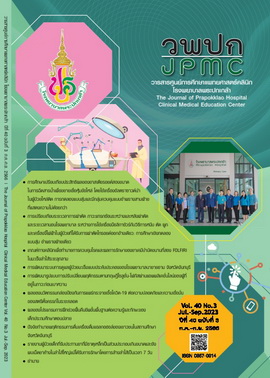The Development of A Palliative Care System for Cancer Patients at Na Yai Am Hospital, Chanthaburi Province
Main Article Content
Abstract
BACKGROUND: Currently, the number of cancer patients is continuously increasing, and cancer has now become the number one cause of death for people in the Na Yai Am District of Chanthaburi, Thailand. At the moment, Na Yai Am Hospital lacks clear palliative care guidelines and its patients lack access to effective services. Therefore, researchers have studied and developed a palliative care system for cancer patients in Na Yai Am Hospital, Chanthaburi Province.
OBJECTIVE: To develop a palliative care system for cancer patients at Na Yai Am Hospital, Chanthaburi Province.
METHODS: Action research involved multidisciplinary teams and cancer patients in Na Yai Am District, Chanthaburi Province. The 73 respondents were selected using purposive sampling by conducting a three-phase study as follows: Phase 1, which involved analyzing the current situation and current problems involving care for palliative cancer patients; Phase 2, which involved designing and developing a model using the Six Building Blocks of a Health System framework and the palliative care paradigm consists of these four fundamental steps: 1) planning for better change (planning), 2) executing the plan (action), 3) observation, and 4) reflection of the process and effect of the change and improving the operational plan (re-planning) to develop the process and follow the four steps repeatedly; and Phase 3, which involved following up and evaluating the results of the development of the palliative care system for cancer patients. Data were collected using questionnaires, in-depth interviews, and group discussion analysis; the descriptive data were analyzed using percentage, mean, standard deviation, paired t-test, and content analysis.
RESULTS: It was found that 52% of cancer patients were female and 45.8% were over the age of 70. It was also found that most patients had breast cancer and 45.8% of the illness period lasted between 1-5 years. All of patients had a family member as their primary caregiver. The patients needed palliative care and the current hospital guidelines for care were unclear. Also, there was lack of communication between providers and recipients and insufficient equipment for patient care. The results of the study and the development of a palliative care model for cancer patients showed that cancer patients had a statistically significant higher mean score of health-related quality of life than before the development (t=4.43, p<0.01), and the mean scores of the satisfaction with the after-service system were significantly higher than before the development (t=7.07, p<0.01).
CONCLUSIONS: From the development of the system, a multidisciplinary participatory care model was created, and the cancer patients had a better quality of life after. The patients were satisfied with their own health and the service system; therefore, this care model should be used as a guideline for the further development of other health service systems.
Article Details

This work is licensed under a Creative Commons Attribution-NonCommercial-NoDerivatives 4.0 International License.
References
Imsamran W, Pattatang A, Supaattagorn P, Chiawiriyabunya I, Namthaisong K, Wongsena M, et al. Cancer in Thailand Vol. IX, 2013-2015. Bangkok: Cancer Registry Unit, National Cancer Institute Thailand; 2018.
Pimpanit P, Isaramalai S, Hatthakit U. Family caregivers’ views and needs for assistance in caring for terminal cancer patients. Thai Journal of Nursing Council 2015; 30(4):57-71.
Boonlerdkerdkrai W. Withholding and withdrawing life-sustaining treatment in palliative care. J Prapokklao Hosp Clin Med Educat Center 2022 ; 39:510-6.
Chaiviboontham S, Pokpalagon P. Palliative care model in Thailand. Int J Palliat Nurs 2021; 27:132-46.
Rotpenpian P, Bunnug P, Tengrunsun S. Knowledge experiences and barriers in advance care plan for terminal cancer patients of family medicine residents. Srinagarind Med J 2021; 36:460-8.
National Cancer Prevention and Control Plan Committee. National cancer control program (2018-2022). Nonthaburi: Department of Medical Services, Ministry of Public Health; 2019.
Health System Reserch Institute(HSRI). 6 building blocks of a health system[internet].2014 [cited 2020 May 27]. Available from: https://www.hsri.or.th/researcher/media/issue/detail/5440
Chatakarn V, Action research. Suratthani Rajabhat Journal 2015;2(1):19-29.
Pattanaphesaj J, Thavorncharoensap M. The Thai Version of the EQ-5D-5L Health Questionnaire. Health Intervention and Technology Assessment Program (HITAP) [Internet]. 2015 [cited 2020 May 7]; 3(24). Available from: https://www.hitap.net/wpcontent/uploads/2015/08/PB_24-EQ5D5L-Eng-Final-for-web.pdf
Victoria Hospice Society. Palliative Performance Scale (PPSv2) version2 [Internet].2015 [cited 2020 May 10]; Available from: http://www.npcrc.org/files/news/palliative_performance_scale_PPSv2.pdf
Jirakangwan M, Chantree S. The development of palliative care in end of life cancer patients: an integration of caring seamless network at Sisaket Hospital Nursing Public Health and Education Journal 2018; 19(2):70-83.
Chanthanuy K, Palachai N, Kunwong P. Model of self-management support for intermediate care and caregiver in the community Yangsisurat District, Mahasarakham Province. Academic Journal of Nursing and Health Sciences 2023;3(1):68-81.
Chanpraset S, Choumthong T, Sriparawong S. The development of palliative nursing care system in department of nursing Chonburi Hospital. J Prapokklao Hosp Clin Med Educat Center 2016;33:326-39.

